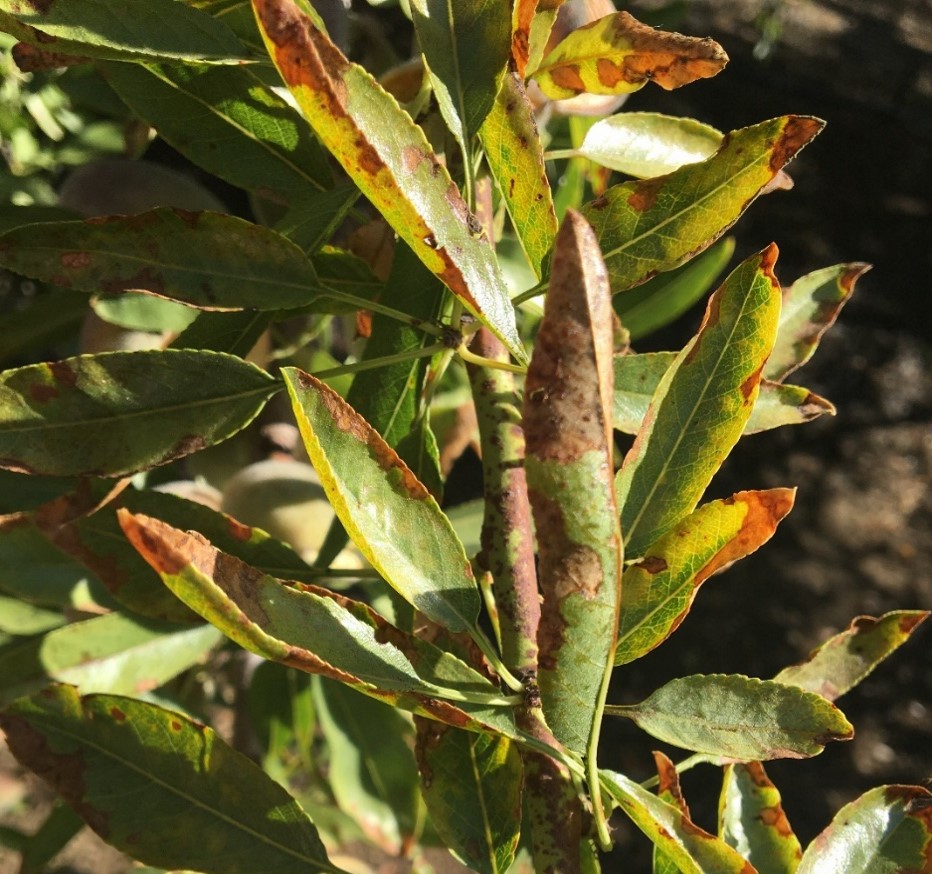Kat Jarvis-Shean, Orchard Systems Advisor UCCE Sacramento-Solano-Yolo
I had a number of farm calls this summer for leaf burn in almonds. It was often much worse in Monterey than the other varieties, and in fields with strong disease management programs. The culprit? Low potassium. It’s an understandable problem to arise when input prices are high and almond prices are low. Gone are the days of throwing on a little extra just in case. Everyone is trying to find that sweet spot of delivering just enough inputs to maintain healthy trees and a good crop, and it’s easy to miss that mark when margins are so thin.

Photo 1. Leaf burn symptoms associated with very low potassium. Potassium leaf concentration in Sonoras was half of the K value in Nonpareil in the same orchard.
Fertilizer management with thin margins is extra tricky with almonds because varieties can yield so differently within a year. Almond potassium demand is largely driven by cropload, which uses 95 lbs K2O per 1000 lbs kernel crop. Ideally, you’d fertilize differently by variety to meet different crop demands. However, most almond orchard fertigation systems are not plumbed to do this. If potassium is applied to orchards with the average yield in mind, the lower yielding varieties are having their needs met and then some, whereas the higher yielding varieties like Monterey are getting shorted.
Post-harvest can be a great time to start catching up on potassium. One potential solution for this would be supplementing heavier setting varieties with soil-applied potassium. Post-harvest is the ideal time for this application if you’re applying potassium chloride and/or if the orchard in question is on drip. Post-harvest is the best time for potassium chloride so that winter rains can leach the chloride out of the root zone. Potassium chloride may not be a good idea for orchards with chloride sensitive rootstocks (Lovell, K86) or a perched water table. Post-harvest is a good time for soil applied with drip systems because the rains can move the potassium into the soil. Post-harvest applied hulls and shells is rarely applied in different weights by cultivar, but can be a lower-cost source of potassium, in general. UC Davis research has found hull or a hull-shell mix contains 57 lb K2O per ton.
Now is also a good time to make a plan for next season. Differential fertilizing using soil applied K can also work during the growing season with SOP, applied in the wetted zone of microsprinklers or drip emitters, though the wetted zone for drip is admittedly a smaller target to hit. The other options would be turning off all but the heavy set variety lines for a fertigation event, or foliar spraying only the heavy set variety. Given that you can only move 5-10 lb/ac of potassium in through the leaves per foliar spray, this is unlikely to pencil out as a cost-effective K catch-up approach. Depending on your labor availability and costs relative to the cost of your K source, running one or two heavy-set-only fertigation events might pencil out. If you saw a little tip burn or off color by variety this year, consider leaf nutrient sampling by variety next year. Another $60 leaf sample (60 cents/acre for a 100 acre block) could give you a heads up before nutrient deficiencies are easy to diagnose visually, at which point they are already impacting tree health.


Leave a Reply